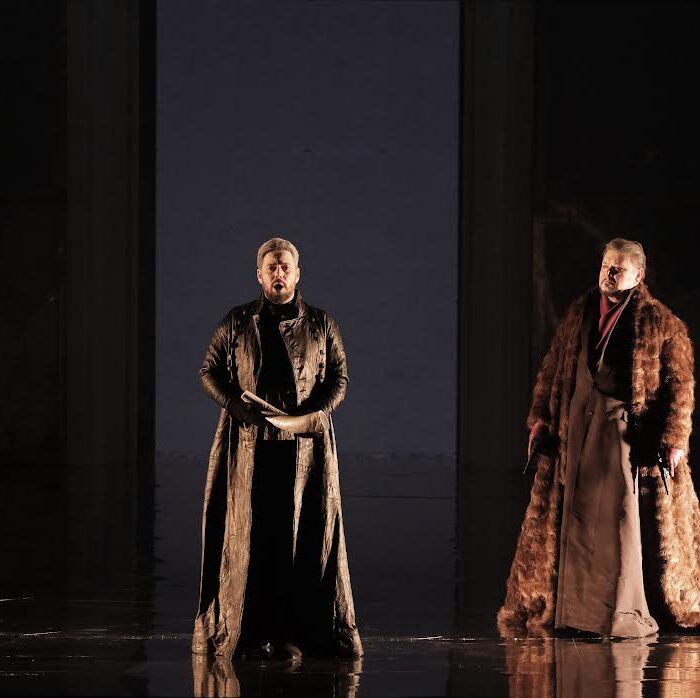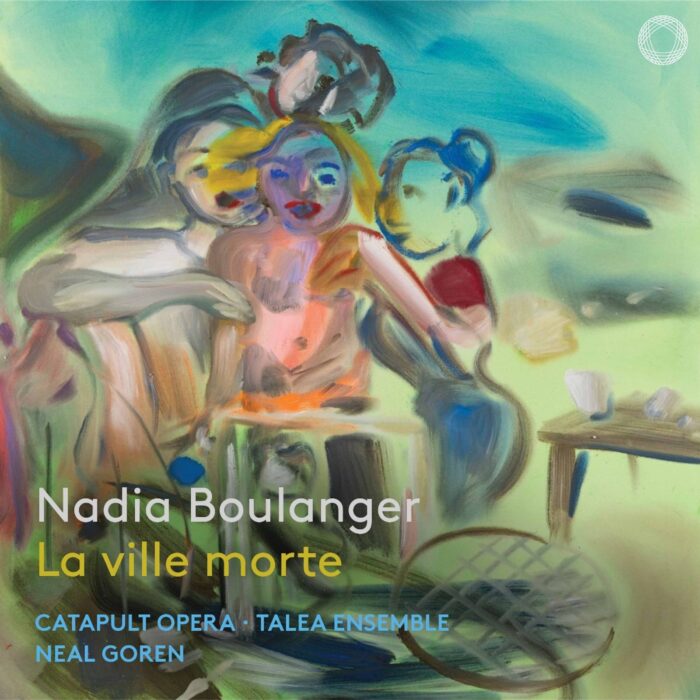
CD Review: George Benjamin & Martin Crimp’s ‘Picture a day like this’
By Joe CadaginEvery six years or so, we’re gifted with an operatic gem from composer George Benjamin and playwright Martin Crimp. Their fourth and latest collaboration, “Picture a day like this,” is a revelation. This live recording, released by Nimbus Records, features the composer conducting the Mahler Chamber Orchestra at the work’s 2023 Aix-en-Provence Festival premiere.
While Benajmin and Crimp’s colleagues on the contemporary opera scene pander to audiences with trendy and timely topics, the British duo returns to truly universal sources—the archetypal myths that transcend time and culture. “Picture a day like this” is an hourlong chamber opera in the pattern of their first creation, “Into the Little Hill”—a dark retelling of “The Pied Piper.”
“Picture” adapts another, less familiar folktale that appears in various guises across the globe. Its plot is deceptively simple: a nameless Woman’s child dies, and the village crones tempt her with a magical solution. If she can track down a truly happy person by the end of the day and cut a button from their clothes, her son will live again.
Crimp’s libretto is reminiscent of “The Little Prince”—the possible candidates on the Woman’s list recall the string of self-deluded grown-ups that Saint-Exupéry’s pint-sized hero encounters. Initially, they seem happy. But as soon as the Woman scratches slightly beneath the surface, she discovers that their happiness is false.
The episodic format offers Benjamin the opportunity to develop a distinct sound world for each of the five contenders. Actually, two distinct sound worlds—one representing their supposed state of felicity and another once the Woman learns the reality of their situation. There’s a moment during each scene when this “switch” occurs, indicated by a drastic change in style and instrumentation.
She first meets two Lovers, a soprano and countertenor, who seem eternally suspended in erotic ecstasy. Their lines, supported by a rustic consort of recorders, intertwine like Poppea and Nerone’s. Benjamin has a way of staggering and overlapping voices that feels both conversational and lyrical—a stylized naturalism that is particularly effective in this duet.
The parodies of swelling Wagnerian climaxes evaporate as soon as the male Lover offhandedly explains that their relationship is open—something the female Lover didn’t entirely agree to. Sputtering brass and side-drum motives intrude, taken up by countertenor Cameron Shahbazi as he stutters out the word “polyamory.” Shahbazi comes off as a smarmy narcissist, yet simultaneously smooth-talking and seductive.
Following the Lovers, the Woman comes across an Artisan—a button-maker, in fact, whose button-covered suit is sonically simulated with a cabasa rattle. Backed by piccolo birdsong, baritone John Brancy ascends into his falsetto, scaling what resembles a natural overtone series.
It’s a delirious and almost giddy happiness that turns out to be, in his words, “dose-related.” To prevent himself from self-harm, the Artisan is dependent on anti-psychotic drugs, which Brancy bellows for with sinister desperation. The strings’ pricking pizzicato and cut-like col legno strokes are uncomfortably suggestive of razor nicks. Brancy offers a performance that is equal parts terrifying and affecting. He reaches a near-shouted A-flat when he exposes the rope-burn around his neck, the ensemble bursting into a fff chord of suffocating intensity.
Crimp wisely follows this with a comic intermezzo featuring an egotistical young composer. Soprano Beate Mordal’s endless self-aggrandizing is accompanied by flashy Vivaldian string figuration. Her execution is hilariously cocky and braggadocious, especially the cartoonish repetitions of “happy, happy, happy” that mask her character’s inner doubt.
The sequence of contrasting musical moments in Benjamin’s score calls to mind “Bluebeard’s Castle,” with its separate sonic palettes for each of the rooms. And as in Bartók’s opera, the scenes are unified by a kind of ritualistic repetition indebted to the structure of fairytales. The beginning of every scene, for instance, is marked by a muted trio of two trumpets and trombone. Its function is akin to the “Promenade” theme between the movements of Mussorgsky’s “Pictures at an Exhibition.” But the little contrapuntal fanfares the trio plays are stylistically closer to medieval music, establishing an archaic atmosphere.
At the close of every scene is a series of clock chimes played on the tubular bells—a reminder that the Woman has until nightfall to carry out her mission. They always toll on the same two pitches, E-flat and D, which emerge as an idée fixe in Benjamin’s score. This descending half-step is first heard in the Woman’s opening line on the phrase “had died” when she relates the passing of her child. The motive’s association with these words, along with it’s keening, downward motion, would seem to connect it to mourning.
But this isn’t a Wagnerian-style leitmotif tied down to a single concept. Benjamin’s approach to musical meaning is closer to the Symbolist movement. It’s why Crimp is such an ideal match for the composer—both artists deal in the inscrutable and the ambiguous, only gradually revealing the half-lit shapes that hover at the edges of our consciousness.
Benjamin’s sonic symbol, though confined to just a pair of pitches, accumulates a vast constellation of associations as the opera progresses. It’s not simply an emblem of sorrow. Rather, it comes to represent the Woman’s obsessive belief that the resurrection of her child will bring her happiness—a notion that we slowly begin to realize is an impossibility, since no happy person exists in her world.
The opera’s cyclicality is momentarily broken halfway through by a solo passage for the Woman—a number that Benjamin explicitly labels “Aria.” Crimp’s ABA-form text would seem to call for a corresponding da capo setting. Yet Benjamin resists this urge. Instead, he traces a wide-ranging emotional trajectory. Mezzo Marianne Crebassa audibly passes through all five stages of grief. Backed by searing quadruple-stop harmonies, she rails against fate, cursing her lot in bitter, sobbing phrases.
Crebassa’s cathartic wail on “I wanted miracles” marks a complete shift in the aria. Her hushed delivery conveys that hollow numbness one feels after weeping. The vocal writing takes on a folksy quality, reminiscent of an Eastern European funeral lament. It closes with a passage of unexpected and unaffected melodic beauty, enveloped in a dewy cloud of harp and celesta. This finely crafted aria is the highlight of a role that is exquisitely tailored to Crebassa’s instrument. Benjamin takes ample advantage of her earthy bottommost register—her groaning low notes are positively gut-wrenching.
Following a Berg-like orchestral interlude on the E-flat/D motive, the Woman finds herself at the twilit home of Zabelle—finally, a truly happy person who dwells in domestic bliss with her family. Benjamin evokes her Edenic garden in lush textures that teem with instrumental activity. As Zabelle, soprano Anna Prohaska describes her paradisiac life in soaring flights of avian coloratura tinged with folk inflections. It’s a performance of such effortless, inhuman perfection that it borders on the impossible.
Indeed, the side drum ricochets that punctuate the scene—which seem to imitate the shimmer of a mirage—hint that all is not what it seems. Zabelle explains that the tableau is merely an illusion, a kind of frozen vision of times long gone. At some point in the past, a group of men invaded her home, seized her possessions, and kidnapped or murdered her husband and children. The details are left purposefully hazy. But considering the Armenian origins of Zabelle’s name, as well as the genocidal allegory of Crimp and Benjamin’s earlier “Into the Little Hill,” it’s likely that she was the victim of an ethnic cleansing. “I’m happy only because I don’t exist,” Zabelle explains before fading away. Meanwhile, the E-flat/D chimes signal that the Woman has failed her task.
Or has she? In the final scene, as the village crones gleefully mock her for trying the undo death itself, the Woman stretches out her hand to reveal a button. Whose? It couldn’t belong to any of the pseudo-felicitous individuals on her list. Nor to Zabelle, who was merely a memory projected into the present. Could it be the Woman’s, cut from her own sleeve? Perhaps she has attained, not happiness—which is dependent entirely on luck and circumstance—but a form of contentment. Or perhaps she’s achieved some Buddhist transcendence of worldly attachment. Benjamin’s closing music again conjures a verdant garden—a personal Eden or Nirvana where the falling half-step motive is transformed into a pastoral cuckoo call on clarinet.
While the libretto of “Picture a day like this” resembles a fable, there’s no pre-packed Aesopian moral at the end. It’s closer to a Zen koan—a paradoxical aphorism or anecdote that isn’t “solvable” in the sense of a riddle, but is meant to inspire meditation. In an age when sanctimonious creators of opera feel compelled to beat listeners over the head with political platitudes, Crimp and Benjamin show genuine respect for their audiences. Their musical myths challenge and provoke, but ultimately allow spectators to glean their own, deeply personal interpretations.



